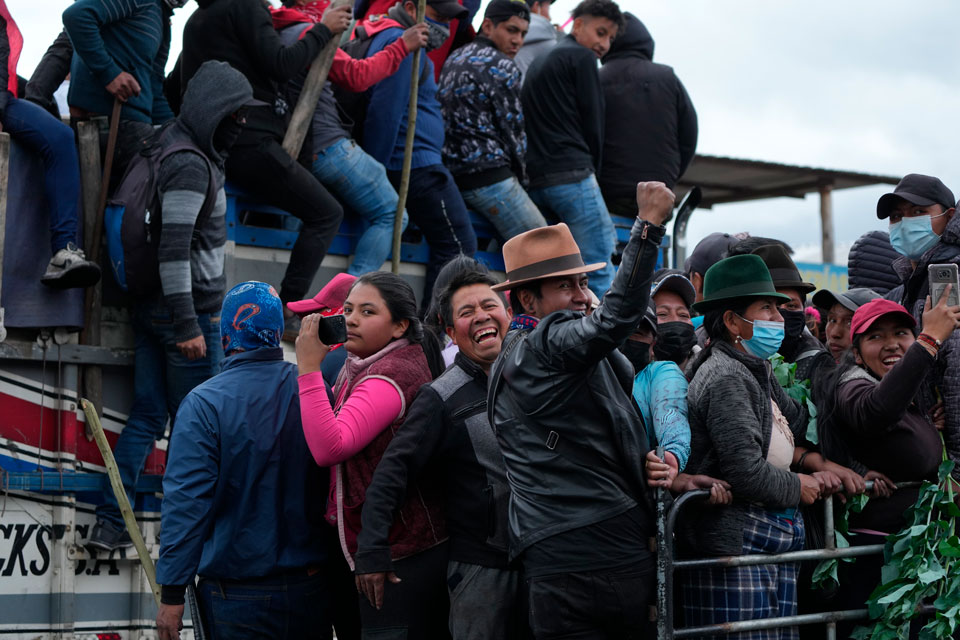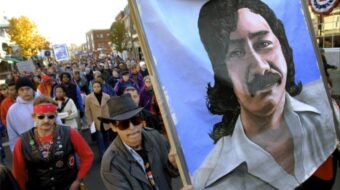
A national strike is unfolding now throughout Ecuador under the auspices of the Ecuadorian Confederation of Indigenous Nationalities (CONAIE, as per Spanish-language initials). It is strong particularly in Cotopaxi, Tungurahua, Chimborazo, and Pastaza provinces. Launched on June 13, the strike has continued for over a week.
On June 20, thousands of marchers entered Ecuador’s capital, Quito. Students may allow some of them to enter Central University in Quito. The Alliance of Ecuadorian Organizations for Human Rights has registered 79 arrests, 55 protesters wounded, and 39 instances of human rights violations.
Reporting from Puyo, in Pastaza province, Bob Shiers, a regular correspondent of the present writer, indicates that, as of June 18: “The only way one can get into Puyo is by foot, bicycle, or motorcycle… Buses and taxis are not operating… This protest consists of 40 different Indigenous groups who speak forty different languages… [T]he Ecuadorian media mainly shows photographs of people from Pichincha, Cotopaxi, and Imbabura provinces, which primarily represent the Quichua people.
“As of yesterday, the oil fields in the Amazonas were shut down. Crude now selling at more than $110 a barrel. Every day tens of thousands of dollars worth of flowers are lost as the union workers at the airport refuse to load them onto planes… In Quito, all the large retail stores are closed.
“The National Teachers’ Union voted to strike… [President Guillermo] Lasso moved the government out of Quito. Much violence between police and students in Guayaquil… in Quito, [there are] violent confrontations between the army and students. This is different from any other mass Ecuadorian indigenous protest since 1990 because the indigenous Pachakutik [Plurinational Unity Movement—New Country] Party controls the national parliament.”
Lasso’s ascent to Ecuador’s presidency in April 2021 pleased banking circles in the United States. As noted by a financial commentator, “The surprising victory for conservative Guillermo Lasso…increases the chances that public debt will be put onto a sustainable path” and that the country’s bonds will gain in value. Within months, revelations surfaced that monies Lasso accumulated as a banker had been stored in off-shore tax havens.
On May 20, an expanded council of CONAIE approved resolutions centering on improved quality of rural life, protection of nature, sustainable agriculture, and repair of economic and political inequalities.
The basis for these resolutions, according to CONAIE, derives from “an analysis of the country’s problems aggravated by a profound economic and institutional crisis, [which in turn stems from] dependence on the powers of the state, a pronounced widening of the inequality gap, and deepening of poverty generally. The national government turns its back on the majority population, favoring the big capitalists and submitting to the International Monetary Fund with its policies of privatization of strategic sectors and of plundering the country.”
Three weeks later, CONAIE announced the launching on June 13 of a “national mobilization of Indigenous peoples, producing sectors, small farmers, and diverse social organizations.” The organization presented a ten-point agenda outlining a range of reforms addressing economic and human-rights injustices.
- Demands included reduced gasoline and diesel prices;
- a one-year moratorium on family debts;
- better prices for agricultural products;
- more credit for farmers; improved education, transportation services, and healthcare;
- labor rights; no mining in Indigenous areas;
- protection of water sources; attention to the rights of nature and to collective rights;
- and controls on privatization, price-gouging, and speculation.
As of the strike’s sixth day, the Lasso government had decreed a State of Emergency, and soldiers and police were deployed in Cotopaxi, Imbabura, and Pichincha provinces. Pichincha is the location of Quito, Ecuador’s capital. Reports quickly surfaced of injuries and arrest of strikers.
The government has relented to the extent of declaring a public health emergency and providing Ecuadorians with a “human development” bonus, a subsidy covering 50% of farmers’ fertilizer costs, partial cancelation of debts owed to the Central Bank, and small low-interest loans for farmers.
CONAIE leader Leonidas Iza welcomed the proposals while pointing out their limited scope and lack of official validation. Iza “reiterated that CONAIE is preparing its entry into Quito in order to continue with anti-government demonstrations.” On June 18, his car came under attack. Bullets shattered one of its windows, but Iza escaped injury.
On the eighth day of the strike (June 21), Bob Shiers provided an update from Puyo: “The road I live on is more than a mile long and is connected at one end to the Puyo-Marcus highway and on the other end to the Puyo-Tenna highway. Right now as far as one can see, there are parked cars on both sides of the road. My landlady said they began arriving at sun-up. She said most cars contained at least four people. What this means, at least in Pastaza Canton, is that the adult bourgeois mestizos have joined the mobilization, even if it means they have a five-mile walk to get there. As my landlady said: ‘Lasso does not have a clue… His cabinet of bankers.’ My landlady’s store is down to tomatoes, flour, corn, rice, oatmeal, and banana!”












Comments